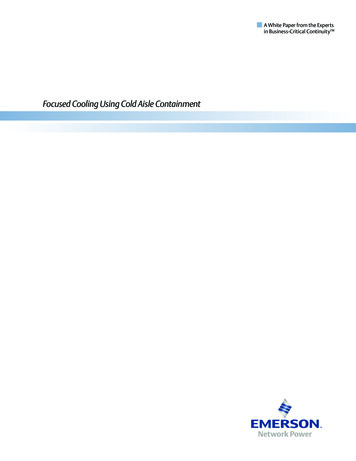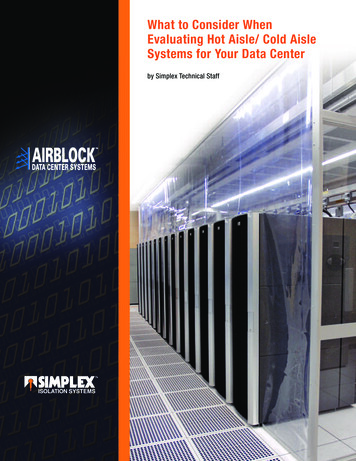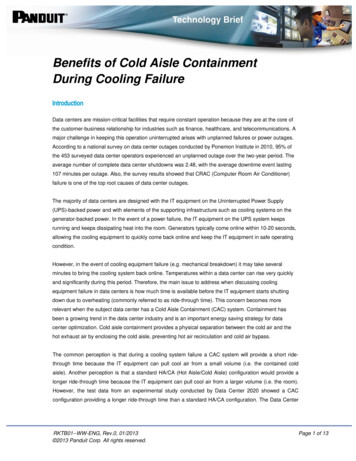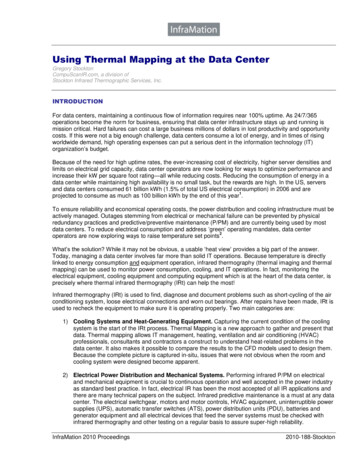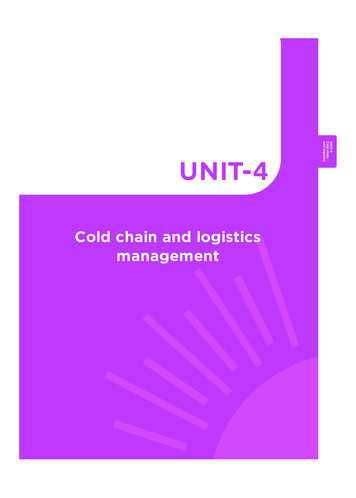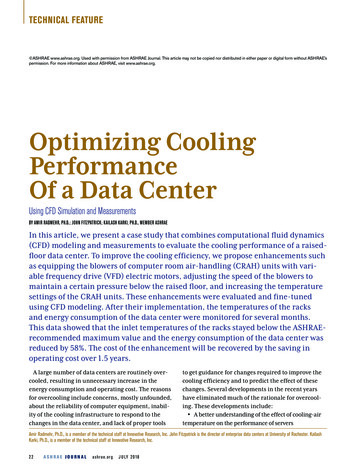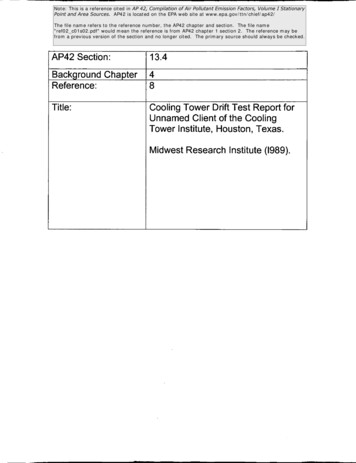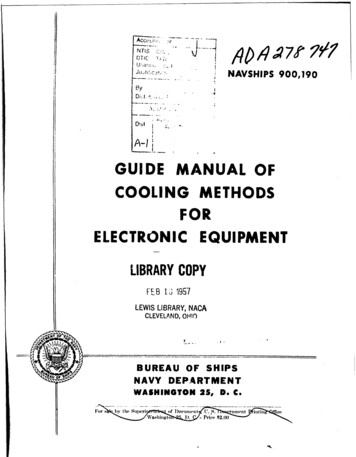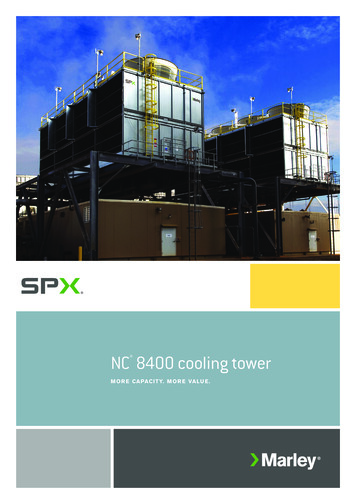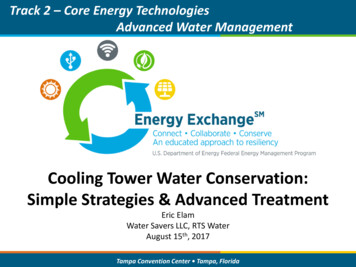
Transcription
FOCUSED COOLING USINGCOLD AISLE CONTAINMENT
TWO STAGE POWER DISTRIBUTIONExecutive SummaryA number of options are available to facilities professionals looking to improve cooling efficiency and reduce resources consumedby their data centers. Beyond implementing basic measures such as sealing moisture out of the data center and improving airflow, aisle containment to prevent the mixing of hot and cold air stands out as a method that can dramatically reduce energycosts, minimize hot spots and improve the carbon footprint of data centers.While either hot aisle or cold aisle containment systems can be installed and are both capable of increasing efficiency and coolingtoday’s high heat data centers, meaningful differences exist in how they function and are implemented. This paper reviews bothapproaches and concludes that cold aisle containment is the superior solution. Cold aisle containment can be used with orwithout conventional raised floor cooling. It is easily retrofitted into existing raised floor data centers and works in tandem with theraised floor as well as with extreme density cooling systems to produce highly efficient cooling solutions.2
IntroductionCooling is the hot topic in data center circles today. As heatdensities and cooling costs rise, data center professionalsare looking for more efficient cooling solutions. Aislecontainment can improve cooling performance of a datacenter, assuming it is arranged in a hot aisle/ cold aisleconfiguration. Gartner reports that a 2007 Pacific Gas andElectric study estimated that containment could save 20percent in chiller operating costs. Further, a 2007 study byLawrence Berkeley National Laboratory found that theelectricity used to move the cold supply air could bereduced 75 percent by implementing cold aisle containment.1As an addition to a conventional precision cooling system,cold aisle containment consistently separates cold andwarm areas without requiring structural changes to thedata center. A cold aisle retrofit can be implemented easilyand quickly, carries a payback time from weeks to a fewmonths - depending on whether energy utility rebates wereavailable to help with funding - and can reduce coolingrelated energy costs by as much as 30 percent.2Cold aisle containment can be used with or withoutconventional raised floor cooling. It is easily retrofittedinto existing raised floor data centers and works intandem with the raised floor as well as with extremedensity cooling systems to produce highly efficientcooling solutions. A feature and benefit matrixcomparing cold and hot aisle containment methodsbegins on page 15.Aisle containment works to remedy this situation. Beforeinstalling aisle containment, however, measures should betaken to improve overall cooling system energy efficiency.Pick the Low-Hanging FruitThe first step to take is implementing certain basicmeasures to increase cooling efficiency, save money andimprove your data center’s carbon footprint.Conventional CoolingSeal the Data Center EnvironmentThe conventional cooling method circulates cold air fromcomputer room precision air conditioning (CRAC) unitsvia a plenum under a raised floor. The CRAC units arelocated outside the rack rows around the perimeter of thedata center.Minimize the latent (moisture related) cooling load bymaking sure the data center has a good vapor barrier, noleaks around doors, windows, etc., and minimal outside airintake. Sealing out moisture will help ensure that the totalavailable cooling can be used to cool the computer heatload, which is 100 percent sensible (no moisture content).Arranging racks into a hot aisle/cold aisle configuration(discussed at right) is a cooling best practice that has beenimplemented to improve the efficiency of raised floor datacenters. However, the hot air can diffuse into the cold airnear the top of the racks and on the end of the cold aisles.The resulting mixed air temperatures can in some cases beunacceptably high for the servers at the top of the racks andat the end of the aisles.The mixing of hot and cold air can be aggravated by a poorbalance between the total cold air demand to the racks inthe aisle and the total supply from the perforated floor tilesin the aisle. Increasing the airflow in the cold aisles may helpovercome the unbalanced conditions, but doing so willincrease energy use, making it a less efficient solution.Optimize Air FlowSeveral techniques can help optimize air flow in thedata center.Arrange server racks in a hot aisle/cold aisle configuration.Most equipment manufactured today is designed to draw inair through the front and exhaust it out the rear. This allowsequipment racks to be arranged to create hot aisles andcold aisles. This approach positions racks so that rows ofracks face each other, with the front of each opposing row ofracks drawing cold air from the same aisle (the cold aisle).Hot air from two rows is exhausted into a hot aisle, raisingthe temperature of the air returning to the CRAC unit andallowing it to operate more efficiently, as shown in Figure 1.3
FOCUSED COOLING USING COLD AISLE CONTAINMENTMinimize cables in the back of the rack. Use a cablemanagement system in the racks so cables do not obstructthe exhaust air from the servers.CRACs should be located at the end of the hot aisles toreduce air travel and prevent hot air from being pulleddown into the cold aisles as it returns to the airconditioner.Install blanking panels in and between the racks. Blankingpanels prevent the hot air from circulating to the front of therack where the electronic equipment air intakes are located.Place the CRAC units correctly in the room. The CRACsshould be located at the end of the hot aisles to reduce airtravel and prevent hot air from being pulled down into thecold aisles as it returns to the air conditioner. Alternatively,use the overhead plenum for hot air return to the CRACs.Seal the raised floor. Make sure that there are no leaks atcable penetrations, perimeter penetrations and raised floortile joints.Minimize cables and pipes under the raised floor. As thesaying goes, old cables never die. If cables have to be in theraised floor or cannot be removed, they should be under thehot aisle running parallel with the aisle.Optimize perforated tile locations. Conducting a thermalassessment of the data center using computational fluiddynamics (CFD) is a good way to optimize the location ofperforated tiles.Adjust Air Supply TemperaturesIn many data centers it is possible to raise the airtemperature and still remain within the ASHRAErecommendations of 64.4 degrees F (18 degrees C) to 80.6degrees F (27 degrees C).3 Raising the temperature reducesthe overall energy required for cooling.Follow Proper Operating GuidelinesMake sure that method of procedures (MOP) and otherprocess documents covering maintenance, installation ofnew equipment, and other aspects of routine operationare current regarding energy efficiency, and that theyare followed.Precision Air Conditioning Unit(CRAC)[Cold Aisle][Hot Aisle][Hot Aisle][Raised Floor][Perforated Tiles]Figure 1: Hot aisle/cold aisle configuration with raised floor.4
Implement System MonitoringMonitoring can predict needed preventive maintenance/actions, such as filter replacement, which help ensure thecooling system is operating efficiently.Implement an Aisle Containment SystemBeyond implementing these baseline measures, a datacenter can further improve energy efficiency by separatingthe hot and cold air streams. Aisle containment, as thissolution is called, is possible once the server racks havebeen arranged in the hot aisle/cold aisle configuration.With aisle containment, the aisle is sealed off so the cold airis not mixed with the warm air in the data center. This istypically accomplished using ceiling panels above the aislebetween adjoining racks and installing doors at the ends ofthe aisle.Pressurized aisles and using plastic curtains are aislecontainment approaches that do not contain the aislecompletely. The pressurized aisle approach has doors at theends of the aisle and cooling modules located above or ontop of the racks. The modules take hot air from the hot aisle,cool it and supply cold air down into the cold aisle.One approach utilizes plastic curtains (fire code approved)installed at the ends of the aisle and between the top of theracks and the ceiling in the room. Plastic curtains canseparate the hot and the cold air, but not as efficiently assolid panels and doors.Aisle containment has two distinct advantages. First, itincreases the cooling capacity and energy efficiencyof the cooling unit and second, the increased capacity,together with the separation of hot and cold air, makesit possible to cool higher heat loads per rack.Aisle Containment BenefitsAisle containment has two distinct advantages. First, itincreases the cooling capacity and energy efficiency of thecooling unit ensuring that the return air temperature to thecooling unit is high. Second, the increased capacity, togetherwith the separation of hot and cold air, makes it possible tocool higher heat loads per rack.Additionally, with hotter air returning to the cooling coil, thecooling capacity available for cooling the sensible heatgenerated by the electronic equipment is increased. Underthese conditions the cool supply air temperature is almostalways above the dew point. Consequently, there is minimalmoisture removal (latent cooling), which saves energy byallocating more of the total cooling capacity to dissipate the100 percent sensible electronic heat load. The minimal latentcooling also increases the total energy efficiency because ofless demand for re-humidification of the air.Two Types of Aisle ContainmentAisle containment can be implemented as either cold aislecontainment (CAC) or hot aisle containment (HAC),configured as shown in Figure 2.Cold Aisle Containment (CAC)ColdAisleRackHot Aisle Containment (HAC)ColdAisleRackHotAisleSide ViewRackColdAisleRackRackHotAisle RackHotRack AisleRackSide ViewFigure 2: Side view of cold aisle containment and hot aisle containment with raised floor.5
FOCUSED COOLING USING COLD AISLE CONTAINMENTPotential Drawbacks to Aisle ContainmentBoth cold aisle containment and hot aisle containmentcan be accomplished in two principally different ways:With the external cooling method, the cooling unit islocated outside the containment and with the internalcooling method, the cooling unit is located insidethe containment.The primary difference between HAC and CAC is that HACis trying to contain the hot air to make sure that the returnair temperature to the cooling unit is high, while the focus ofCAC is on supplying cold air to the cold aisle where theequipment air intakes are located. The HAC approach canresult in high efficiency of the cooling unit, but because thecold air distribution to the servers is open and exposed todisturbaances from the room, it has a higher risk of notproviding the server with its required input temperature.Similar to HAC, CAC yields high air temperature to thecooling unit to increase capacity and efficiency. However,with its focused cooling, CAC supplies the high heat densityracks with cold air with minimal impact from thesurroundings. Therefore, it can enable a higher airtemperature leaving the cooling unit, which increases thecapacity/efficiency of the unit while supplying airtemperature to the servers within the ASHRAErecommendations.Both cold aisle containment and hot aisle containment canbe accomplished in two principally different ways:yyWith the external cooling method, the cooling unit islocated outside the containment (typically a raised floorsystem with perimeter-located CRAC units).yyWith the internal cooling method, the cooling unit islocated inside the containment (typically above orbetween the racks).See also the feature and benefit matrix comparing cold andhot aisle containment methods, for both external andinternal approaches, on page 15.6Aisle containment can save considerable money for coolingthe data center and also enable cooling of higher heat loadsper rack, but there may be some drawbacks. The followingare the most common objections to aisle containment.Potential code issues regarding fire protection – Contact thelocal fire authority to discuss any aisle containment plans tomake sure that codes are followed.Aesthetics and accessibility – Aisle containment willchallenge the traditional image of a data center with openspaces and open access to racks and equipment.Environment for personnel – Because the contained aisleapproach separates the cold and hot air, the temperatures inthe room will change. Additionally, the sound level canchange. The sound from the servers, and from the coolingunits inside the containment if the internal cooling method isused, will be lower in the room outside the containmentbecause of the sound-dampening aisle containment.However, inside the containment space, it will seem louderbecause of the containment.Expandability – Racks inside the aisle containment must beexpanded in even numbers. Additional aisle panels must beinstalled and the door modules must be relocated.Requires hot aisle/cold aisle rack configuration – This entailslining up server racks in alternating rows with cold-airintakes all facing one aisle, hot-air exhausts the other. Theaisle containment approach does not work with rear doorheat exchangers that cool the rack exhaust air before itenters the room.Thermal ride-through – In a traditional data center with anopen layout/architecture, a power failure to the coolingsystem will make the air temperature to the racks riserelatively slowly because the room air volume can work as athermal storage to ride through short power outages. Howfast the temperature will rise to a level where the serversstart to shut down depends on many site specific factors:heat load per rack, thermal mass in the room and size of theroom, among others.
In a data center with aisle containment, the temperature tothe racks will rise faster in case of a power failure because ofthe smaller contained air volume. Full scale tests show thatwith no containment in large rooms and low heat densities,the time to server shut down can be 30 minutes or longer;high heat densities in a contained aisle installation can givejust a few minutes of thermal ride-through time.It should be noted that thermal ride through time for CACand HAC will be similar in a power failure situation where thecooling system, including the air circulating fans, is notrunning. In a CAC installation, the exhaust side of a rack isopen while the inlet side is a closed limited air volume;therefore, server fans will not be able to move air throughthe servers in the racks. In an HAC installation, the inlet sideof a rack is open but the rack exhaust side is a closedlimited air volume, resulting in the same inability of theserver fans to move air through the servers in the racks. Theclosed limited air volume is similar for HAC and CAC.In a data center with aisle containment, thetemperature to the racks will rise faster in case ofa power failure because of the smaller containedair volume.Computational Fluid Dynamics (CFD) of AirTemperatures With and Without CACFigure 3 below shows the improvements in airtemperatures accomplished with cold aisle containmentin a room with high heat density racks cooled by traditionalraised floor cooling.AirTemperature90 F (32.2 C)80 F (26.7 C)70 F (21.1 C)60 F (15.6 C)50 F (10 C)Without CACWith CACFigure 3: Computational Fluid Dynamics (CFD) top view (5 feet above the floor) example of air temperatures in a room with high heat densityracks cooled by traditional raised floor cooling, shows isolated, uniform cooling in the cold aisles with CAC compared to without CAC.Average return air temperature to the CRACs without CAC is 75 degrees F (23.9 degrees C) and with CAC it is 85 degrees F (29.4 degrees C).The room with CAC requires two fewer CRAC units.7
FOCUSED COOLING USING COLD AISLE CONTAINMENTBoth cold aisle and hot aisle containment methods willaddress high heat densities and improve coolingefficiency. However, they bear significant functionaldifferences that should be kept in mind when selectinga containment solution for the data center.Cold Aisle vs. Hot Aisle ContainmentAs mentioned previously, both containment methods willaddress high heat densities and improve cooling efficiency.However, they bear significant functional differences thatshould be kept in mind when selecting a containmentsolution for the data center.Hot Aisle Containment with External Cooling(Cooling unit outside the containment, typically raisedfloor application)Hot aisle containment offers efficiency improvementscompared to traditional non-contained cooling approaches,but it also exhibits some limitations:Cooling is not focused cooling – In HAC, the cold airdistribution from the cooling unit that exhausts to the serverrack inlet is “open” and dependent on surrounding areaconditions and equipment. The open air distributionincreases the risk of providing the servers with input air thatis not the required temperature.Air temperatures potentially are high – Because of thecontainment of the hot aisle, which limits the mixing/leakingof cold air into the hot aisle, air temperatures can exceedacceptable levels for personnel working in the aisle.Requires complete hot air ducting – For HAC to workcorrectly and avoid mixing hot and cold air, the hot return airmust be ducted all the way from the HAC to the air inlet ofthe CRAC.This typically entails using the overhead plenumfor return air (if possible), ducting between the HAC andceiling plenum, and ducting between the ceiling plenum andthe CRACs.8Requires overhead space – Overhead space is needed forthe hot return air plenum/ducts.Creates additional cooling load – Using a ceiling plenum andadditional return air ducts gives additional pressure drop inthe air circulation that needs to be handled by larger fansthat consume more power and add cooling load to the room.Limits ability to retrofit – HAC can be difficult to install as aretrofit, especially without interrupting data center operation,because of the additional required ducting.Inefficiency of chimney rack – One version of hot aislecontainment is called the chimney rack. This is a rack with aseparate rear chimney for the hot air exhaust. The chimneyis connected to a hot air return plenum/ ducting in theceiling. Typically this approach limits flexibility, uses extraoverhead space and also requires exhaust fans at each rack.These fans consume significant energy and add cooling loadto the room. Also, the air flow can only work properly if theservers are sealed in place. If a server or blanking panel isremoved for service, the chimney flow can be interruptedcausing hot air to escape back into the cold side of the rack.Hot Aisle Containment with Internal Cooling(Cooling unit inside the containment)From an efficiency perspective, HAC with internal coolingcan be more advantageous than with external cooling.However, several limitations still exist:Cooling is not focused cooling – As with HAC with externalcooling, in HAC with internal cooling, the cold air distributionfrom the cooling unit that exhausts to the server rack inletis “open” and dependent on surrounding area conditionsand equipment. The open air distribution increases the riskof providing the servers with input air that is not therequired temperature.Air temperatures potentially are high – Because of thecontainment of the hot aisle, which limits the mixing/leakingof cold air into the hot aisle, air temperatures can exceedacceptable levels for personnel working in the aisle.
Takes up floor space – Cooling units are typically floormounted between the racks in the middle of the data center,taking up premium floor space.Does not work in conjunction with raised floor cooling – Canbe used in a raised floor installation but typically not inconjunction with raised floor cooling. In a room with bothraised floor cooling and HAC, the raised floor cooling shouldnot be expected to provide cooling for the racks included inthe HAC system unless the HAC, in addition to the internalcooling, also has complete hot air ducting all the way to theair inlet of the CRAC.Requires piping for chilled water or DX-based cooling – Eachcooling unit requires pipes/connections for chilled water ordirect expansion applications. The data center needshumidity control and, if dehumidification (latent cooling) andhumidification are provided in the row-located cooling unit,both water drain and water supply piping are required in theheart of the data center. Without a raised floor, the waterpiping for the cooling units inside the HAC typically must beinstalled above the electronic equipment.Cold Aisle Containment with External Cooling(Cooling unit outside the containment, typically raisedfloor application)Cold aisle containment with external cooling is typicallydeployed in a traditional raised floor environment withperimeter located cooling units, as shown in Figure 4.Cold aisle containment with external cooling istypically deployed in a traditional raised floorenvironment with perimeter located cooling units, asshown in Figure 4.The CAC approach encloses the cold aisle with ceilingpanels above the aisle between adjoining racks and withdoors at the end of the aisle, so the cold air from theperforated floor tiles in front of the cabinets is contained anddelivered to the electronic equipment air inlets. The CACprevents cold air from mixing with warm air or beingobstructed by surrounding equipment/sources before itreaches the servers. Because CAC possesses this ability, it iscalled focused cooling.Cold aisle containment with external cooling can typicallycool 10 to 15kW heat load per rack. However, maximumcapacity depends on site specific factors such as raisedfloor height, rack layout and others.In addition to its ability to cool high heat densities, thefocused CAC approach also:Increases cooling capacity and efficiency – Minimizes coldand hot air mixing so the return temperature to the coolingunit is higher. This enables increased cooling unit capacity,as shown in Figure 5, and increased efficiency, as shown inFigure 6. Also, because of the focused cooling approach,CAC can enable a higher air temperature leaving the coolingunit (and still supply air temperature to the servers withinthe ASHRAE recommendations), which will further increasethe sensible capacity/ efficiency of the unit.Retrofits easily – Unlike hot aisle containment, CAC is easyto install in an existing data center. Adding CAC to anexisting raised floor installation only entails adding coverpanels above the aisles and doors at the end of the aisles.Typically this can be accomplished quickly without ashutdown. Space requirements for CAC are almost negligible.Figure 4: Cold aisle containment deployed in a traditionalraised floor environment.Uses the existing raised floor cooling infrastructure –Most data centers are using raised floor cooling andCAC can extend the raised floor performance with only aminor investment.9
FOCUSED COOLING USING COLD AISLE CONTAINMENTChilled Water CRACSensible Capacity Increase (%)80Direct Expansion CRAC70605040302010070 F21.1 C75 F23.9 C80 F85 F90 F26.7 C29.4 C32.2 CReturn Air Temperature95 F35.0 C100 F37.8 CFigure 5: Typical CRAC cooling capacity increase (normalized at 75 degrees F (23.9 degrees C)) at different return air temperatures.(Fixed CW flow rate for the CW CRAC).Chilled Water CRAC80Direct Expansion CRACEfficiency Increase (%)70605040302010070 F21.1 C75 F23.9 C80 F85 F90 F26.7 C29.4 C32.2 CReturn Air Temperature95 F35.0 C100 F37.8 CFigure 6: Typical CRAC cooling capacity increase (normalized at 75 degrees F (23.9 degrees C)) at different return air temperatures.(Chiller and CW pumping not included for the CW CRAC).10
Cold Aisle Containment with Internal Cooling(Cooling unit inside the containment, typically above orbetween the racks)Cold aisle containment with internal cooling can coolmore than 30kW heat load per rack.Cold aisle containment with internal cooling can bedeployed in a traditional raised floor environment or ona slab. Similar to CAC with external cooling, CAC withinternal cooling has a focused cooling approach andcontains the cold air by enclosing the cold aisle using topceiling panels and doors at the end of the aisle. However,with internal cooling, the cold air is delivered to thecontained aisle from cooling units located inside thecontainment, above or between the racks. The cooling unitstake the hot air directly from the hot aisle, cool it and deliverit to the cold aisle.Cold aisle containment with internal cooling can cool morethan 30kW heat load per rack. Additional advantages withthe focused CAC approach include:40Liebert XDO20Increased cooling capacity and efficiency – Mixing of coldand hot air is minimized so the return temperature to thecooling unit is higher. In addition, the location of the coolingunit close to the heat source gives a higher return airtemperature to the coil, compared to when the cooling unitis located outside the containment. This further increasesthe cooling unit capacity (see Figure 7) and efficiency(see Figure 8). In addition, because the cooling unit is inclose proximity to the heat generating racks, much lessenergy is required for air movement compared to coolingapproaches with the cooling unit located outside thecontainment. The savings in energy required for airmovement is typically at least 75 percent and, for acomplete system, at least 30 percent.Liebert XDV10Liebert XDH20Liebert XDH32Sensible Capacity (kW)3530252015105080 F26.7 C85 F29.4 C90 F32.2 C95 F35.0 C100 F37.8 C105 F40.5 C110 F43.3 CReturn Air TemperatureFigure 7: Cooling unit capacity at different return air temperatures (at 60Hz).11
FOCUSED COOLING USING COLD AISLE CONTAINMENTCan be used with a raised floor – Unlike HAC, the CAC canbe used in conjunction with raised floor cooling. The CACwith internal cooling works in tandem with raised floorcooling to provide the contained cold aisle with cold air, asillustrated in Figure 9.Unlike HAC, the CAC can be used in conjunction withraised floor cooling. The CAC with internal coolingworks in tandem with raised floor cooling to providethe contained cold aisle with cold air, as illustratedin Figure 9.Also, because of the focused cooling approach, CAC canenable a higher air temperature leaving the cooling unit(and still supply air temperature to the servers within theASHRAE recommended guidelines), which will furtherincrease the capacity/efficiency of the unit.Efficiency Ratio, SCOP 4 , Unit Fans Only(kW out/kW in)70Liebert XDO20Available with top mounted non-water based cooling units,Liebert XDV or Liebert XDO, so no floor space in themiddle of the data center is used for cooling equipment, orwith high capacity non-water based floor mounted coolingunit, Liebert XDH – Liebert XD pumped refrigerant-basedcooling provides focused, efficient and flexible high heatdensity cooling. The pumped refrigerant is ideal for usearound electronic equipment. It operates at low pressure inthe piping circuit and if a leak were to occur, theenvironmentally friendly refrigerant would escape as a gas,causing no harm to critical equipment.Liebert XDV10Liebert XDH20Liebert XDH32605040302010080 F26.7 C85 F29.4 C90 F32.2 C95 F35.0 C100 F37.8 C105 F40.5 C110 F43.3 CReturn Air TemperatureFigure 8: Cooling unit efficiency ratio at different return air temperatures (at 60Hz).12
yyThe Liebert XDO overhead cooling module mountsdirectly above the cold aisle, requiring no floor space.It draws in hot air from the hot aisle, then dischargescool air into the cold aisle where the equipment air inletsare located.yyThe Liebert XDV top cooling module mounts verticallyon or above the IT rack enclosure, requiring no floorspace. It draws hot air from inside the cabinet or from thehot aisle. It then cools the air and discharges it down tothe cold aisle.yyThe Liebert XDH in-the-row cooling module is placeddirectly in line with the rack enclosures, and requiresvery little floor space. Air from the hot aisle is drawnin through the rear of the unit, cooled, and thendischarged horizontally through the front of the unitinto the cold aisle.Figure 9: Cold aisle containment with Liebert XDVunits mounted on top of the racks and raised floorcooling working in tandem.13
FOCUSED COOLING USING COLD AISLE CONTAINMENT14ConclusionReferencesWhile hot aisle and cold aisle containment systems both arecapable of increasing efficiency and cooling today’s highheat data centers, cold aisle containment better addressesthe task of separating hot and cold air while supplying coldair to the servers. Cold aisle containment has a focusedcooling approach and can be used with or withoutconventional raised floor cooling. It is easily retrofitted intoexisting raised floor data centers and will create highlyefficient cooling solutions when used in tandem with raisedfloor and/or extreme density cooling systems.1., 2. Gartner, 2008. McGuckin, Paul. Cool More WithLess in Your Data Center.3. 2008 ASHRAE Environmental Guidelines forDatacom Equipment - Expanding the RecommendedEnvironmental Envelope.4. ANSI/ASHRAE Standard 127-2007 Method of Testingfor Rating Computer and Data Processing Room UnitarywAir Conditioners.
Feature/Benefit MatrixHOT AISLE CONTAINMENTExternal Cooling(Cooling Unit LocatedOutside theContainment)FEATUREBENEFITFocused coolingLess exposure of coldair delivery to thesurroundings increasesavailability and efficiencyLow complexity ofcooling redundancyLower initial costEnergy efficiencyLower operating costsAbility to retrofit inraised floor installationsIncreased flexibility inretrofit scenariosCapability to cool highheat densitiesAllows racks to be filledwith high heat emittingequipmentNo waterAvoids water relatedrisks in the middle of thedata centerFloor space efficientThermal ride throughEnab
Cooling is the hot topic in data center circles today. As heat densities and cooling costs rise, data center professionals are looking for more efficient cooling solutions. Aisle containment can improve cooling performance of a data center, assuming it is arranged in a hot aisle/ cold aisle configuration. Gartner reports that a 2007 Pacific Gas and
